Off The Hook #2
Hi again. I’m Joe Reilly and welcome to the second edition of ‘Off The Hook’ where I report and examine the latest happenings of the MMA (Mixed Martial Arts) world. In this issue I will take a closer look at the upcoming show: UFC 45. However the main focus of this edition is an analysis of the ground game in MMA. Are you new to the sport of MMA and even if your not, have you grasped the mystery of the ground game of MMA yet? Read on and all will be revealed about the biggest mystery of MMA to most new fans to the sport.
One thing that has personally helped me grasp the ground game of MMA quicker is that I study Brazilian Jiu Jitsu, which has been easily the most influential form of Submission fighting in the evolution of MMA. However, I am not saying that all you newcomers to the sport should immediately go out and join your nearest Brazilian Jiu Jitsu Dojo. Although it would help you understand and appreciate the art of fighting on the ground and I would encourage anyone to take Jiu Jitsu up, I’m just making the point that it’s not necessary if all you want to do is learn how to understand this element of fighting more.
First of all, there are two main types of grappler in MMA. There is the wrestler and the Jiu Jitsu guy. Just to eliminate any confusion, when I say wrestler, I am not referring to a pro wrestler, but rather an amateur wrestler studying either the art of Greco Roman or Freestyle wrestling or both. Of course, you also have guys such as Hidehiko Yoshida who are expert Judo guys, but I’ll just stick with both the wrestler and Jiu Jitsu guy, as they are the two most common types of grappler in MMA.
In MMA today, all the top guys study as many arts as possible to be the most well rounded fighter as humanly possible. However, in most cases the well-rounded fighter is stronger in one main aspect of their game, which in most cases is the art that they first started. An example of this would be UFC Welterweight Champion Matt Hughes. Matt’s foundation of fighting is wrestling and it is still his most valuable asset, even though he has evolved to be a well-rounded martial artist.
There can also be exceptions to this rule. UFC Heavyweight contender Frank Mir is a prime example of this. As a kid Frank first studied Kempo Karate under his father’s guidance, but when he started getting interested in Vale Tudo and wanting to train to be an Ultimate fighter, Brazilian Jiu Jitsu became Mir’s deadliest weapon in his arsenal.
Now, to make the following information as simple, but as informative as possible I will divide the ground game of MMA into all it’s individual positions and I will explain the tendencies of both a wrestler and a Jiu Jitsu guy in each position. The positions I will cover are the following:
- Guard top position
- Guard bottom position
- Side mount position
- Full mount position
- North South position
- Back mount position
- Front Headlock position
I will explain the advantages and disadvantages of each position for both fighters involved. Before I go on to the specifics of each position I will say that the main goal for a fighter on the ground should be to either submit their opponent or knock them out. There are several different positions on the ground. Some are advantaged positions, some are disadvantaged positions and some are neutral positions.
While fighting on the ground the fighter normally has a better chance of finishing the fight when in an advantaged position, but they also are likely to be finished when caught in a disadvantaged position. Normally when both fighters are in a neutral position, they both have good chance of finishing each other. Now, we move on to the specifics.
Guard top position
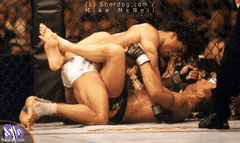
Carlos Newton in Guard top position in the closed guard of Pat Miletich
The first position I am going to cover is guard top position. When a fighter has guard top position this is another way for saying that this particular fighter is in their opponent’s guard. This is when the fighter on the bottom (while on their back) uses their legs as a barrier to prevent the fighter on top to advance to an advantaged position. Both fighters can attack from this position and therefore it’s considered a neutral position. When in guard top position, a fighter has a few options.
First of all they can stay in their opponent’s guard and decide to go for a knock out or submission. Their second option is to try and pass their opponent’s guard and therefore move on to a more advantaged position such as full mount or side mount.
What a fighter decides to do from here depends on his/her preference, but in most cases wrestlers prefer to pound their opponent from here with strikes or pass the guard to get in a more advantaged position to pound. Also, many Jiu Jitsu guys tend to attempt a guard pass from here or a submission.
Guard bottom position
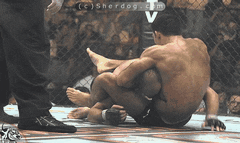 Murilo Bustamante sets up a Guillotine choke on Matt Lindland from Guard bottom
Murilo Bustamante sets up a Guillotine choke on Matt Lindland from Guard bottom
The next position I am going to cover is guard bottom position. This situation is the same as guard top position, but in this case we are referring to the fighter who’s on bottom i.e. the fighter using their guard to prevent their opponent from passing. Just like the previous position it’s a neutral position for both fighters meaning both fighters are in positions where they could successfully attack each other. The fighter who is in guard bottom position or who is pulling guard has a number of different options at their disposal. By keeping a closed guard, the fighter on bottom is preventing the guy on top from passing and if he holds the guy down securely enough he may be also able to defend strikes better from this position.
If a wrestler has their opponent inside their guard and they are not as confident in their submission game, they may opt to use a defensive closed guard and wait for a suitable opportunity to sweep the fighter on top. On the other hand, if a Jiu Jitsu guy is the one on bottom holding guard, they may also choose to close their guard defensively when their opponent is trying pound from that top position, but when the opportunity presents itself they are more likely to open their guard (open their legs).
When a fighter plays an open guard game, normally it means they are either looking to sweep (reverse) the guy on top or else go for a submission. Generally Jiu Jitsu grapplers are more offensive from this position i.e. looking for all sorts of submission opportunities like armbars, triangle chokes, shoulder locks etc.
Side mount position
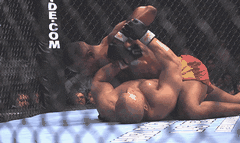 Vernon White acquires Side mount on Ian Freeman
Vernon White acquires Side mount on Ian Freeman
This next position I am going to cover, I will do so differently than the last two positions. Instead of outlining all possible scenarios for each fighter in this exchange separately, I will outline each fighter’s predicament i.e. the guy on top and the guy on bottom all in this one section.
First, we’ll go with they guy on top. This position is called side mount, but is more commonly referred to as side control because the guy on top in this exchange is in complete control and the only way he can lose that control is if he gives the guy on bottom space or the opportunity to make some space to escape or reverse him.
When the guy on top has successfully achieved side control, he has passed the guard of his opponent while they lie on their back and therefore he has achieved an advantaged position. From here the fighter on top is in a position to attack in the manner that they see fit. From here they can be aggressive or passive. If the fighter on top doesn’t think his/her side mount is secure enough, they may opt to be briefly more passive by simply adjusting the pinning position they have on their opponent or switching to another advantaged position that they prefer like north south mount or full mount.
On the other hand if the fighter feels comfortable from this position they will likely be more aggressive by either going for a submission, strikes or knee ride. The knee ride is when the fighter chooses to mount their opponent with a knee. Some fighters use this to put extra pressure on their opponent, which can make it easier to successfully land strikes or pull off successful submission attempts from here.
The bottom line is that most wrestlers will tend do rely on strikes from this position or else switch to another advantaged position they can achieve such as full mount or North South. On the flipside, most Jiu Jitsu grapplers will be going for a submission attempt if it presents itself or they may opt to switch to another advantaged position.
For the fighter who is on bottom position and on their back while their opponent has side control, it is a lot more difficult for them because if their opponent knows what they are doing they should be able to successfully control them from here. The main thing the fighter on bottom should be trying to do here is to regain their guard or else try to reverse their opponent.
The main way the fighter on bottom can achieve one of these preferred positions is by taking advantage of space that the opponent on top has given them. If the fighter on top leaves the fighter on bottom with enough space to get their arms inside, the fighter on bottom can use their own arms to create space to get their legs back in and regain their guard, but in most situations fighters on bottom will have to really work hard to create space, as their opponent will not give up space to them easily.
Full mount position
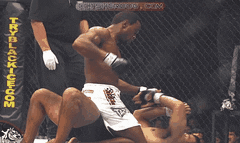 Pete Spratt throws down some strikes from Full mount on Robbie Lawler
Pete Spratt throws down some strikes from Full mount on Robbie Lawler
When a fighter has acquired full mount position, they are passed their opponents guard and have attained another type of advantaged position with their opponent on their back. Here, the fighter on top has a number of options. He/she can choose to ground and pound i.e. when a fighter dominantly lands strikes from a top position (Many wrestlers like Matt Hughes and Tito Ortiz like to use this form of attack). They can also go for submissions such as chokes and armbars (Jiu Jitsu grapplers like Carlos Newton or Murilo Bustamante prefer this method of attack).
The main thing the fighter on bottom can do to defend ground and pound is put their hands up to block the strikes or hold the opponent’s body or arms down so they cannot rise up and land heavy strikes. The fighter on bottom should also be aware of the right situations to attempt a reversal i.e. when the fighter on top is in between attacks and may be off balance as a result.
Also if the fighter on bottom is able to make enough space like in the side control predicament, they may also be able to regain guard from here.
North South position
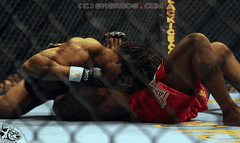 Carlos Newton establishes North South position on top of Pete Spratt
Carlos Newton establishes North South position on top of Pete Spratt
This is another advantaged position for the fighter who is on top. North South position in a manner of speaking is a full mount with a 180-degree change in position i.e. when the fighter on top holds the guy on bottom down from the opposite position to full mount.
From here, the fighter that’s on top can either land some strikes or go for submission attempts. This is a position that has different rules between UFC and PRIDE. In PRIDE not only can you land punches and forearms from here, but you are also able to land knees to the head but in UFC you are not able to land knees from here.
In PRIDE a fighter can land knees to the head while on the feet and on the ground. In PRIDE, you can also stomp a downed opponent. UFC doesn’t allow stomping of this manner. However, a rule that both promotions share on the ground is that no fighter can use the base of their elbow as a weapon. Both organisations allow fighters to use forearm strikes, where they can connect with the edge of the elbow, but fighters are not allowed use of the pin point of their elbow for strikes.
The reason why PRIDE are more liberal with their ground attack rules is because PRIDE has its bouts in a ring while UFC has theirs in an Octagon shaped cage. The sanctioning bodies in the USA would not allow similar ground rules in the UFC, as it is much more difficult for a fighter who is defending these types of strikes on the ground while in a cage compared to a ring.
Some people use these rule differences to criticise UFC as an argument to claim PRIDE is better. I believe those arguments to be nonsense. In UFC, the aggressor of a fight can push their opponent up against the cage to trap their opponent so they can land strikes, so I do not question why stomps and knees to the head (while on the ground) are not allowed.
A fighter getting stomped or taking knees to the head on the ground in PRIDE is in a much better position to defend themselves than in UFC. If you are the fighter who is being attacked with these types of strikes, you can scramble to defend yourself easier when against the ropes compared to being held up against a solid fence.
Also if two fighters in PRIDE are against the ropes for too long, the referees are bound to move them back to the centre of the ring and they will be forced to restart in the same position. In UFC, this will not happen, but the referee can stand them up if neither fighter is trying to improve their position or score points. Both UFC and PRIDE will stand up two fighters if there is inactivity on the ground.
Back to the North South position on the ground. From here, the fighter that is on his/her back must find a way to either scramble and get to their feet, reverse the aggressor or somehow swing around back to guard.
Back mount position
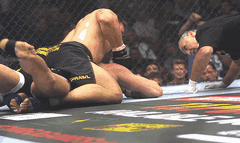 Frank Mir attempts a rear naked choke on Wes Sims from Back mount
Frank Mir attempts a rear naked choke on Wes Sims from Back mount
This is also an advantaged position for the fighter who has control of their opponent’s back, while it is a very disadvantaged position for the fighter who has their back mounted by the aggressor. One of the main factors in this exchange as in any position is whether the aggressor wishes to land strikes or go for a submission such as a rear naked choke.
A lot of wrestlers prefer to pound their opponent with strikes from this position, as Tito Ortiz showed when he beat Guy Mezger the second time they fought. Also, many solid Jiu Jitsu grapplers prefer submissions from here, as Genki Sudo showed when he beat Leigh Remedios by rear naked choke at UFC 38: Brawl At The Hall in England last year.
If the aggressor wants to strike, he can only land strikes to the side of his opponent’s head and back. So, the aggressor cannot strike to the spine or to the back of the head. The type of back mount that the aggressor wants to use depends on how quick they capitalise on attacking their opponent from this position.
The main goal for most fighters from this position will normally be to first get their hooks in i.e. get both of their legs inside and around their opponents abdomen and then hook their legs between their opponent’s thighs. The reason for this is so the fighters on top can secure their own balance, which makes it easier to attack from this position. They now have a better chance of being successful in landing strikes or locking in any submissions.
The fighter on bottom with their back exposed should be trying their best to shake of the aggressor or turn themselves back around so they are facing their opponent, but of course this is easier said than done, especially if the aggressor has both their hooks in from here.
Front Headlock position
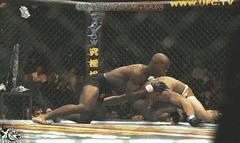 Yves Edwards tries to maintain Front Headlock position on Rich Clementi
Yves Edwards tries to maintain Front Headlock position on Rich Clementi
This is also an advantaged position for the guy on top and disadvantaged one for their opponent. The position is self-explanatory. The aggressor normally starts off in this position with some type of front headlock. From that, the aggressor can land some sneaky punches to the head or body or if they hold them down fully some hard strikes. Also, the aggressor can switch to a guillotine choke from here and pull guard to increase the pressure of the submission.
Also, from this position the opponent has their back exposed, so if the aggressor is quick enough from this position the may be able to hop around and acquire back mount on their opponent. Fighters in PRIDE can also land knees to the head from this position while UFC fighters cannot. UFC fighters are only allowed knees to the body while on the ground.
From here, the fighter on bottom must try to either scramble to their feet or roll back and pull guard on their opponent. So, there you go. I have explained all the main positions of the ground game to you. I hope it was informative, but relatively easy to understand also. So, before I signal the end of this column I am going to list the current line up for the upcoming UFC show and briefly go through some news bits.
UFC 45: Revolution
21st of November 2003
Lightweight Bouts
Yves Edwards vs. Nick Agallar
Welterweight Bouts
UFC Welterweight Championship
Matt Hughes (c) vs. Frank Trigg
Robbie Lawler vs. Chris Lytle
Middleweight Bouts
Matt Lindland vs. Niko Vitale
Phil Baroni vs. Evan Tanner
Keith Rockel vs. Chris Leguori
Heavyweight Bouts
Wesley ‘Cabbage’ Correira vs. David ‘Tank’ Abbott
Pedro Rizzo vs. Ricco Rodriguez
There is the line up for that show and it is an impressive card too. You may notice that the card has been slightly adjusted, as both Din Thomas and Pat Smith got injured. Therefore, Nick Agallar will replace Din Thomas, while the Frank Mir vs. Pat Smith fight has been removed from the card. The show still has a great line-up despite the late adjustments to the card. The only other noteworthy news item is European related and that is that Setanta Sports a global PPV company based in Dublin, Ireland will be showing live coverage of UFC 45 on the 21st of November.
This is great news for all European fans that have access to Setanta Sports. Setanta Sports is an independent PPV provider, but they operate their service through SKY Digital. If you can’t see this event in your own home or a friend’s home, please check Setanta.com for additional information on various clubs and bars that will be televising the event throughout Europe.
Well, that’s enough information in this week’s column. Please remember to check back next week, where I will take an in depth look at the upcoming PRIDE show and some other news bits. I will also try to add more coverage of the European MMA scene starting next week, as it’s about time some of the lads at SBG Ireland and their fellow European competitors get some of the spot light. For those of you that don’t know about SBG Ireland, I’ll talk more about this organisation next week. For any information on upcoming fights in Europe, please check the news board in the International & MMA section.
Before I sign off, I would like to thank Sherdog for all the pictures used in this article and remind people that they are not the property of our site, as they belong to Sherdog. For anyone interested in finding pictures from past events, you should try their archived galleries at the following address:
Sherdog.com/pictures.cfm
Well, with all that said, I bid you farewell once again and look forward to bringing you another column for next week and remember, please email me your comments, folks.
Until next week and as always, support MMA!
Cheers,
Joe Reilly
